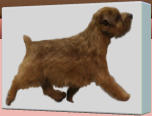

Breeders Corner

Kafka said, "All knowledge, the
totality of all questions and
answers, is contained in the dog."

Please submit your article,
publication or hyperlink to an
article to Judi Hartell.
DataDawg@Austin.rr.com
Submissions

Quote



The Bluebonnet Norfolk Terrier Club does not recommend,
guarantee, endorse, nor rate these recommendations or
contributors, their kennel or their stock. The purpose of this section
is to share the knowledge and experience of breeders who have vast
experience in whelping and raising puppies. The tips and tricks
below are intended to augment qualified veterinarian care, not as a
substitute for qualified veterinarian care of the dam and puppies.






Contributed from Dr. Andrew Kramer:
Basically, if you're a Fluffy then you are homozygous for the long-haired gene and
testing is irrelevant. This leaves those dogs who are phenotypically short-haired. The
proportion of short-haired dogs that carry the long-hair gene (i.e. heterozygotes)
is a function of the frequency of the long-hair allele in the breed and the level of
inbreeding. If the frequency of the long-hair allele is small and/or inbreeding is high,
then the vast majority of short-hair dogs will not carry the gene for long-hair.
Since inbreeding is high in our breeds and fluffies are rare, the chance of a short-hair
carrying the long-hair gene is very small.
IMHO I would only test if I had a fluffy in the litter, and wanted to know if the other pups
were carriers.

Jerold S. Bell, D.V.M., clinical assistant professor of genetics at Tufts University School of
Veterinary Medicine, Bell says •
The clinically normal full sibling of a carrier has a
50 percent chance of being a carrier.
From Magda Omansky Dignpop Norwich Terriers
CLEFT PALATE Good news is that bitches who were bred again after giving birth to pups
with cleft palates did not have any other puppies with the problem when they were
supplemented with Folic Acid. I spoke about the problem extensively with Dr. Padgett's
team at Michigan State( the most definite authority on the subject) who believe it's an
autosomal recessive traits with modifiers. Dr. Padgett's theory is that an environmental
trigger must be present but it's an inheritable trait. Once a bitch, or a stud produced a
pup with the problem, the future breedings should take it into consideration and ideally
not double up on known carriers. Having said that, it's possible to have even multiple
repeat breedings without a problem if the environment is highly controlled (eg. low
dose of Vit A in food, high doses of Folic Acid, absence of pesticides in dog's
environment etc.). Since the defect needs an environmental trigger you can avoid it, but
you must be aware that in pairing dogs who produced cleft palates we're passing this to
all offspring and they become carriers. If we breed a dog that produced it to the dog
that never did, while supplementing with Folic Acid, we have a 50-50 chance of getting
clear progeny and carriers, and no affected dogs. Probable high numbers of affected
dogs being born recently has mostly to do with higher percentages of environmental
triggers: lawn pesticides, dog food full of allergens, not enough Folic Acid in the diet etc.
The genes have been there for a long time, but now we "activate" them with our more
polluted environment and less natural food.


- Behavior
- Honor Roll
- Living With Norfolk Terriers
- Fun With Your Norfolk
- Tip Of The Week
- Publications
- Therapy and Service Dogs
- Health & Nutrition
- Competition


- Books
- Clubs
- Collectibles, Gifts & Fun Activities
- Companion Animal Recovery
- Dog Show Superintendents
- Genetics
- Health Related Sites
- Canine Health Links
- Vaccination Protocols
- Animal Health Trust
- Online Mendelian Inheritance In Animals
- Univ. Of Cambridge Vet. School
- Canine Inherited Disorders Database
- All Creatures Veterinary Hospital
- A First Aid Kit
- Veterinary Pet Insurance
- AKC Pet Health Plan
- Cornell Univ. College of Vet. Medicine
- More Health Related Sites
- Independent Sites
- Pet Travel
- Training Your Puppy
- Publications


- Breeding Tips
- Breeding Tips Page One
- Breeding Tips Page Two
- Breeding Tips Page Three
- Breeding Tips Page Four
- Breeding Tips Page Five
- Breeding Tips Page Six
- Virus &The Pregnant Bitch
- Dog Neutering Video
- Vaccinations & The Pregnant Bitch
- Incontinence In The Pregnant Bitch
- Flagyl & The Pregnant Bitch
- Canine Reproduction
- Frozen vs Chilled Semen
- Modern Breeding Management
- Dialogue On Rasberry Leaves
- Monitoring Pregnancy
- Uses For Vaginal Cultures
- OFA & The Pregnant Bitch
- Breeding Tips Page Seven
- Breeding Tips Page Eight
- Breeding Tips Page Nine
- Breeding Tips Page Ten
- Breeding Tips Page Eleven
- Breeding Tips Page Twelve
- Breeding Tips Page Thirteen
- Breeding Tips Page Fourteen
- Genetics And Inheritance
- Rescue









